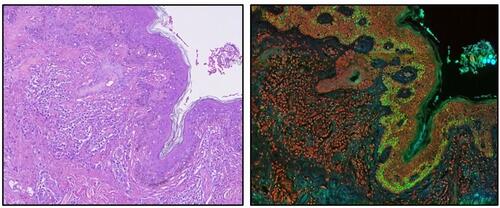Biomarker Panel Characterizes Rare Phyllodes Breast Tumors
By LabMedica International staff writers
Posted on 28 Jan 2015
Cancer researchers have established a panel of biomarkers that characterizes the rare phyllodes form of breast tumors.Posted on 28 Jan 2015
Phyllodes tumors are rare fibroepithelial tumors that represent about 1% of all breast tumors. While most phyllodes tumors are benign, they do have the potential to become metastatic, and little is known about the genetic alterations that drive tumor initiation and/or progression.

Image: Micrograph of a phyllodes tumor (right of image) with the characteristic long clefts and myxoid cellular stroma. Normal breast and fibrocystic change are also seen (left of image) (Photo courtesy of Wikimedia Commons).
To better understand the genetic underpinning of phyllodes tumors, investigators at the University of Michigan (Ann Arbor, USA) used targeted next-generation sequencing (NGS) techniques to identify somatic alterations in formalin fixed paraffin embedded (FFPE) patient specimens from malignant, borderline, and benign cases.
NGS revealed mutations in mediator complex subunit 12 (MED12) affecting the G44 hotspot residue in the majority (67%) of cases spanning all three histological grades. In addition, loss-of-function mutations in the p53 (TP53) oncogene as well as deleterious mutations in the tumor suppressors retinoblastoma (RB1) and neurofibromin 1 (NF1) were identified exclusively in malignant tumors. High-level copy number alterations (CNAs) were nearly exclusively confined to malignant tumors, including potentially treatable gene amplifications in EGFR (epidermal growth factor receptor) and IGF1R (insulin-like growth factor 1 receptor).
"We know little about the biology of phyllodes tumors. In part, they have not been studied much because it is difficult to accumulate a large number of samples. Using these new sequencing techniques, we were able to study archived tissue samples, which allowed us to identify enough samples to perform a meaningful analysis," said senior author Dr. Scott A. Tomlins, assistant professor of pathology and urology at the University of Michigan. "Even though phyllodes tumors are rare, it is important to have good treatment options for the aggressive cases. The first step is to understand the underlying biology of these tumors. Further study and validation is needed, but our work has identified several promising targets involved in phyllodes tumors."
The study was published in the January 15, 2015, online edition of the journal Molecular Cancer Research.
Related Links:
University of Michigan













